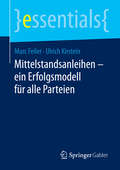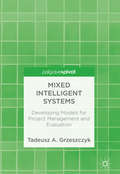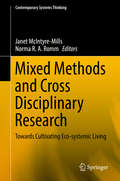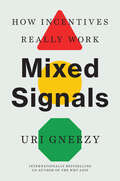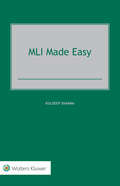- Table View
- List View
Mittelständische Unternehmen: Herausforderungen und Chancen für die 90er Jahre
by Jürgen BerthelDieses Buch gibt die Vorträge namhafter Referenten aus Wissenschaft und Praxis anläßlich eines Symposiums zu Problemen und Chancen mittelständischer Unternehmen wieder. Sie behandeln die folgenden sechs für die Mittelstands-Praxis als am bedeutsamsten angesehenen Fragestellungen: 1) Besteuerung (Autor: Gerd Rose): Leitlinien der Steuerplanung für mittelständische Unternehmen; 2) Staatliche Förderung von Produktinnovationen (Autor: Richard Köhler): Analyse öffentlicher Förderprogramme für Produktinnovationen in mittelständischen Unternehmen; 3) Automatisierte Fertigung (Autor: Horst Wildemann): Konzepte des Einsatzes einer flexibel automatisierten Fertigung wie Computer-Integrated Manufacturing (CIM) und Just-In-Time-Produktion (JIT); 4) Personalpolitik (Autor: D. von Eckardstein): Darstellung von Schwachstellen und Möglichkeiten zur Verbesserung der Personalpolitik bei Mittelständlern; 5) Einsatz von Expertensystemen (Autor: P. Mertens): Darstellung der Möglichkeiten und Vorteile des Einsatzes von Expertensystemen in mittelständischen Unternehmen; 6) Erfolgsfaktoren der Zukunft (Autor: H. Henzler): Erläuterung zukünftiger Erfolgsfaktoren und Problemlösungsmöglichkeiten zu den wichtigsten Problembereichen des Mittelstandes. Das Buch zeigt Schwachstellen in den verschiedensten Funktionsbereichen der betrieblichen Praxis auf. Gleichzeitig wird eine Fülle von Lösungsmöglichkeiten und Anregungen zu Gestaltungsformen gegeben, um den Anforderungen der Zukunft erfolgreich begegnen zu können.
Mittelständische Unternehmen (ZfB Special Issue #4/2013)
by Petra Moog Peter WittDie Forschung zu kleinen und mittelgroßen Unternehmen (KMU) hat eine lange Tradition in der deutschsprachigen Betriebswirtschaft. Dieses Special Issue stellt neue Erkenntnisse aus der empirischen vor, speziell beantwortet es Fragen des Managements von Mittelstand und KMU. Die Beiträge bilden die aktuelle theoretische und methodische Vielfalt ab und bieten Anregungen für weitere Forschungsarbeiten auf diesem Gebiet.
Mittelständische Unternehmen in Polen: Ihre Entwicklung und ihr Einfluß auf den Transformationsprozeß (Beiträge zur Mittelstandsforschung #6)
by Eva Mroczek Liliane von Schuttenbach Mieczyslaw CiurlaDie Entwicklung der mittelständischen Strukturen im polnischen Transformationsprozeß wird in diesem Buch herausgearbeitet und der Einfluß von KMU auf den Verlauf der Transformation im Land untersucht. Um die wichtigsten Modernisierungsimpulse der KMU herauszufiltern, wurde zuerst das Gründungsgeschehen der KMU in Polen analysiert. Dabei sind die Bedeutung und der Einfluß landestypischer Besonderheiten bei der Etablierung des polnischen Mittelstandes hervorzuheben. Des weiteren stellt sich die Frage inwieweit sich die Wirtschaftspolitik der polnischen Regierung fördernd auf den Aufbau selbständiger Existenzen ausgewirkt hat. Nachdem der Einfluß der mittelständischen Unternehmen auf das Wirtschaftsgeschehen mit Hilfe makroökonomischer Indikatoren in einer überwiegend quantitativen Analyse aufgezeigt wurde, sind die Untersuchungen (qualitativer Natur) in Bezug auf die rechtlichen und institutionellen Rahmen gesondert durchgeführt worden.
Mittelstands-Rating: Externe Credit Ratings und die Finanzierung mittelständischer Unternehmen
by Christoph KleyChristoph Kley analysiert Einsatz und Nutzen von Mittelstands-Ratings vor dem Hintergrund der Finanzierungsprobleme mittelständischer Betriebe, der Veränderungen des Kreditwesens durch Basel II, der Stärken und Schwächen banküblicher Ratingsysteme und der Erfolgsfaktoren kleiner und großer Ratingagenturen.
Mittelstandsanleihen: Ein Leitfaden für die Praxis
by Konrad Bösl Peter Thilo HaslerAnleihen mittelständischer Emittenten haben seit der Einführung der speziellen Börsensegmente ab Mitte 2010 ein erhebliches Gesamtemissionsvolumen erreicht. Denn die Vorteile von Mittelstandsanleihen liegen auf der Hand: Der Unternehmer gibt keine Stimmrechtsanteile ab, die Rechtsform seiner Gesellschaft bleibt unverändert und er muss – im Gegensatz zum Bankkredit – keine Sicherheiten stellen oder Covenants beachten. Immer mehr Mittelständler nutzen daher in Zeiten von Basel III die Unternehmensanleihe als ergänzendes Instrument in der Finanzierungsstruktur, auch um gegenüber Banken unabhängiger auftreten zu können. Wir sprechen mit unserem Buch all diejenigen an, die sich ausgiebig über dieses neue Wachstumssegment informieren wollen. Das Buch wendet sich an Privatanleger und professionelle Vermögensverwalter, an Journalisten, Finanzanalysten und Unternehmensberater, aber auch an das Management mittelständischer Gesellschaften, das eine Anleiheemission in Betracht zieht. Ausgewiesene Experten decken thematisch alle relevanten Bereiche einer Mittelstandsanleihe ab, vom Wertpapierprospekt über das Rating bis zum Credit Research, von der Bedeutung der Anleihe im Finanzierungsmix der Unternehmen bis hin zu ihrer Platzierung bei privaten und institutionellen Investoren.
Mittelstandsanleihen – ein Erfolgsmodell für alle Parteien (essentials)
by Marc Feiler Ulrich KirsteinDie noch relativ junge Finanzierungsform der Mittelstandsanleihe ermöglicht es kleineren und mittleren Unternehmen, sich Fremdkapital über den Kapitalmarkt zu beschaffen und so ihre Finanzierung breiter aufzustellen. Wichtige Parameter einer Mittelstandsanleihe sind das Emissionsvolumen, der Kupon, das Rating und die „Bond-Story“. Institutionelle wie private Anleger stellen hohe Forderungen an Transparenz und Kommunikation des Emittenten – für noch nicht börsennotierte Unternehmen eine neue Herausforderung.
Mittelstandsförderung durch „Planification“? (Abhandlungen zur Mittelstandsforschung #24)
by Helga GroteIn der Wirtschaftspolitik kündigt sich seit einiger Zeit ein Stilwandeil an. Dar unter ist eine gewisse Abwendung von der Marktwirtschaft unter gleichzeittiger Hinwendung zu einer wirtschaftlichen Rahmenplanung zu verstehen. Frankreich, das bereits über eine neunzehnjährige Erfahrung mit der Wirtschaftsplanung ver fügt, ist der stärkste Befürworter dieser Politik, die kurz als "Planification" be zeichnet wird. Nach den Bestrebungen Frankreichs oder der Meinung der EWG Kommission soll die Planification französischer Prägung in der einen oder anderen Form auch in die Europäische Wirtschaftsgemeinschaft Eingang finden 2. Aber nicht nur von außen, sondern auch aus Kreisen mittelständischer Unternehmer 3 in der Bundesrepublik wurde der Ruf nach "Planification" laut. Es ist daher interessant zu untersuchen, wie die Rahmenplanung in unserem Nachbarland aufgebaut ist und welche Erfolge sie dort für sich verbuchen kann. Daraus lassen sich gewisse Rück schlüsse auf die möglichen Ergebnisse und Auswirkungen einer Wirtschaftsplanung in der Bundesrepublik Deutschland ableiten. Zu diesem Thema ist in letzter Zeit sehr oft Stellung genommen worden. Gerin ges Augenmerk wurde dabei der Bedeutung der Planung für den gewerblichen Mittelstand geschenkt. Diese Schicht ist aber in den demokratischen Staaten (im Gegensatz zu den totalitären Staaten des Ostblocks) besonders stark vertreten und hat hier auch eine bestimmte Funktion zu erfüllen: "Die Mittelschichten sind die breite Trägerschaft für unsere westliche Staats- und Gesellschaftsordnung, die durch Privateigentum und Rechtsstaatlichkeit gekennzeichnet wird. " 4 Daher soll die "Planification" hier speziell hinsichtlich ihrer Bedeutung für die mittelständischen Unternehmer untersucht werden. 1 Vgl. E.
Mittelstandsmanagement: Einführung in Theorie und Praxis
by Holger ReinemannDieses Buch zum Mittelstandsmanagement liefert in sechs prägnanten Kapiteln kompaktes Wissen für die Führung von mittelständischen Unternehmen. Es beleuchtet die Herausforderungen, mit denen KMU und auch Familienunternehmen in ihren klassischen Lebenszyklus-Phasen konfrontiert sind: die Gründung, das Wachstum, die Reife und die Wende. Fallstudien und Praxisbeispiele ergänzen die theoretischen Abschnitte. Jedes Kapitel bildet eine eigene themenbezogene Lerneinheit. Das Buch dient als Lehrbuch für Studierende mit dem Fokus auf Themen des Mittelstands und ist gleichzeitig sehr zu empfehlen für Geschäftsführer mittelständischer Unternehmen und alle, die eine Unternehmensnachfolge ins Auge fassen.In diesem Buch werden die vier Phasen thematisiert, die KMUs im Laufe der Zeit durchleben. Holger Reinemann begnügt sich jedoch nicht mit der reinen Beschreibung dieser Phasen. Er schürft tiefer, um dem Leser die Unternehmensführung zu erleichtern. Konkret beschäftigt er sich mit den folgenden Themen:Mittelständische Unternehmen: Miniatur-Ausgabe der Konzerne?Gründungsphase: Unternehmen schaffen neue MärkteWachstum: Schwellen der UnternehmensentwicklungDie Reifephase: Bewährung und Bewahrung mittelständischer StrukturenDie Wendephase: Erneuerung oder Niedergang?Auf diese Weise beschreibt das Buch in verständlicher Art alle wichtigen Aspekte der Führung von mittelständischen Unternehmen.
The Mitterrand Era: Policy Alternatives and Political Mobilization in France
by Anthony DaleyThis anthology examines the effects of economic orthodoxy on the French left. A decade after the governing left relinquished plans to 'transform society', French social actors have indeed changed. They have adapted to economic orthodoxy and to a new political mainstream. Various essays examine the political impact of economic forces. They explore the relationships between left parties and organized labour. The book also looks at new forms of political mobilization around gender, immigration, and environmental issues.
Mittlere Manager in Veränderungsprozessen: Aufgaben, Belastungsfaktoren, Unterstützungsansätze
by Doris WieserMittlere Manager bilden in Veränderungsprozessen die Schaltstelle zwischen strategischen Vorgaben und deren operativer Umsetzung. Diese Sandwichposition zwischen Topmanagement und operativen Führungskräften sowie Mitarbeitern kann mit starken Belastungen verbunden sein. Doris Wieser liefert eine Aufbereitung des aktuellen Forschungsstandes und eine Analyse der Belastungssituation mittlerer Führungskräfte im Wandel aus der Perspektive von fünf gängigen Stresstheorien. Darüber hinaus wird in dieser anwendungsorientierten, qualitativen Forschungsarbeit den Fragen nachgegangen, welchen Beitrag die mittlere Führungsebene zum Erfolg von Veränderungsprozessen leistet und wie sie durch den Personalbereich optimal unterstützt werden kann.
Mittleres Management: Aufgaben — Funktionen — Arbeitsverhalten (neue betriebswirtschaftliche forschung (nbf) #135)
by Peter WalgenbachPeter Walgenbach präsentiert die Befunde einer empirischen Studie, in der mit neueren Konzepten aus Managementforschung, Soziologie und Psychologie das mittlere Management untersucht wurde.
Mittleres Management - Schlüssel zum Unternehmenserfolg: Leitfaden zur Führung, Förderung und Beratung des "Sandwichmanagements"
by Anna Dorothea WalterDieses Buch zeigt, dass mit Hilfe von motivierten, leistungsstarken Mittleren Führungskräften, die einen guten Draht zu Mitarbeitern, Kunden und Top Management haben, die besten Strategien entwickelt und umgesetzt werden können, um am Ende Rekordgewinne einzufahren. Mit einem demotivierten, ausgebrannten Mittleren Management ist hingegen eine Talfahrt sämtlicher Unternehmenskennzahlen vorprogrammiert. Experten haben in letzter Zeit viel über das Mittlere Management geschrieben und sind sich über dessen Schlüsselrolle weitgehend einig. Dieses Buch beantwortet die wichtigsten Fragen rund um die Unternehmensmitte: "Wie wird ein Sandwichmanager zur Schlüsselfigur des Unternehmenserfolgs? Worauf kommt es beim Zusammenspiel unterschiedlicher Hierarchieebenen an? Wie sieht eine optimale Personalentwicklung für die Unternehmensmitte aus? Die Autorin erläutert wissenschaftlich fundiert und praxisnah, wie man das wertvolle "Sandwichmanagent" als Erfolgsfaktor einsetzt, anstatt sein Potenzial ungenutzt zu lassen.
Mixed Economy: Proceedings Of Section F (economics) Of The British Association For The Advancement Of Science, Salford, 1980
by Eric RollMixed Fortunes: An Economic History of China, Russia, and the West
by Vladimir PopovThe rise of the West is often attributed the presence of certain features in Western countries from the 16th century that were absent in more traditional societies: the abolition of serfdom and Protestant ethics, the protection of property rights, and free universities. The problem with this reasoning is that, before the 16th century, there were many countries with social structures that possessed these same features that didn't experience rapid productivity growth. This book offers a new interpretation of the 'Great Divergence' and 'Great Convergence' stories. It explores how Western countries grew rich and why parts of the developing world (South and East Asia and the Middle East) did not catch up with the West from 1500 to 1950 but began to narrow the gap after 1950. It also examines why others (Latin America, South Africa, and Russia) were more successful at catching up from 1500 to 1950, but then experienced a slowdown in economic growth compared to other developing countries. Mixed Fortunes offers a novel interpretation of the rise of the West and of the subsequent development of 'the rest' and China and Russia, important examples of two groups of developing countries, are examined in greater detail.
Mixed Intelligent Systems: Developing Models for Project Management and Evaluation
by Tadeusz A. GrzeszczykCorrectly functioning evaluation systems directly influence the efficient and effective planning and implementation of projects and the achievement of organisational objectives. This book critically analyses the results of research dedicated to mixed intelligent systems for project evaluation, taking into account the current state of knowledge in the field of project management. It argues for the need to move away from classical concepts and deploy interdisciplinary research methods in the development of comprehensive project evaluation systems. Considering contemporary issues relating to project evaluation, the author deals with both quantitative and qualitative evaluation methods and the problems surrounding systems that integrate them, before discussing the process of modelling mixed intelligent systems. Mixed Intelligent Systems makes a thought-provoking case for harnessing interdisciplinary methods and new ideas in project management research when developing evaluation systems.
Mixed Intelligent Systems: Developing Models for Project Management and Evaluation
by Tadeusz A. GrzeszczykCorrectly functioning evaluation systems directly influence the efficient and effective planning and implementation of projects and the achievement of organisational objectives. This book critically analyses the results of research dedicated to mixed intelligent systems for project evaluation, taking into account the current state of knowledge in the field of project management. It argues for the need to move away from classical concepts and deploy interdisciplinary research methods in the development of comprehensive project evaluation systems. Considering contemporary issues relating to project evaluation, the author deals with both quantitative and qualitative evaluation methods and the problems surrounding systems that integrate them, before discussing the process of modelling mixed intelligent systems. Mixed Intelligent Systems makes a thought-provoking case for harnessing interdisciplinary methods and new ideas in project management research when developing evaluation systems.
Mixed Method Research Design: An Application in Consumer-Brand Relationships (CBR)
by S. Sreejesh Sanjay MohapatraThis book is a comprehensive guide to design and conduct the research in management-related field, such as marketing management and human resources management. It provides an overview of the real research conducted by authors throughout their careers and explains the important and growing research design used in management research-mixed method research design. Video tutorials are also included for complete qualitative data collection and data analysis. These videos are included to help readers understand the research and apply the techniques using the recommended software programs. Mixed Method Research Design: An Application in Consumer-Brand Relationships (CBR) begins with an introduction, providing background on the study including related literature in the areas of consumer-brand relationships, which helps the book to show how research questions and research objectives can be developed for the mixed method study. This is followed by a detailed explanation of the methodology, which establishes the ground rule for the study. Finally it takes look at the analysis and results of mixed method research study. Additionally the book examines the procedures of mixing of qualitative and quantitative paradigms in research both in terms of hypothesis development and testing. It helps readers understand how to design their research studies using mixed method design. It also demonstrates managerial implications, to help understand how mixed research design could be used to show contribution to the theory and practice.
Mixed Methods and Cross Disciplinary Research: Towards Cultivating Eco-systemic Living (Contemporary Systems Thinking)
by Norma R. A. Romm Janet McIntyre-MillsThis book uses mixed methods to extend the concept of “wellbeing stocks” to refer to dynamic ways of working with others. It addresses metaphors and praxis for weaving together strands of experience. The aim of the wellbeing stocks concept is to enable people to re-evaluate economics and to become more aware of the way in which we neglect social and environmental aspects of life. The pursuit of profit at the expense of people and the environment is a central problem for democracy and governance. The vulnerability of cities is a symptom of the lack of balance between individual and collective needs. This book explores the potential for cities, specifically in the regions of Indonesia, Africa, and Australia, to become more productive as sites for food and water security through more creative use of technology. It highlights the need for partners that see food and security feasible at the household level if supports are provided at the community, national and international level. The book examines how these regions are affected by demographics, climate change and people movements, but also explores ways to establish an effective cultural ecosystem management.
Mixed Methods Research Design for the Built Environment
by Julius Akotia Bankole Osita Awuzie Charles EgbuThe application of mixed methods research design in the built environment discipline by students and academics has continued to grow exponentially. However, with no dedicated mixed methods research design textbook in this domain, students have struggled to conduct research projects involving a mixed methods research design. Mixed Methods Research Design for the Built Environment provides a useful research methodololgy resource for students, academics, and researchers across various disciplines in the built environment such as construction management and project management, property and real estate management, quantity surveying and commercial management, building surveying, building services engineering, civil and geodetic engineering, and other built environment disciplines. The book can also be useful for students and academics outside the built environment knowledge domain. This textbook offers practical and step-by-step guidance on how to apply mixed methods research design, including an elucidation of the various philosophical and methodological underpinnings upon which the choice of a particular variant of the mixed methods research design is predicated. It provides practical case examples and guidance on the processes involved to design and undertake mixed methods research, the advantages and disadvantages of using mixed methods research, and how multiple sources of qualitative and quantitative data can be combined and applied to carry out research projects.
Mixed Methods Research Design for the Built Environment
The application of mixed methods research design in the built environment discipline by students and academics has continued to grow exponentially. However, with no dedicated mixed methods research design textbook in this domain, students have struggled to conduct research projects involving a mixed methods research design. Mixed Methods Research Design for the Built Environment provides a useful research methodololgy resource for students, academics, and researchers across various disciplines in the built environment such as construction management and project management, property and real estate management, quantity surveying and commercial management, building surveying, building services engineering, civil and geodetic engineering, and other built environment disciplines. The book can also be useful for students and academics outside the built environment knowledge domain. This textbook offers practical and step-by-step guidance on how to apply mixed methods research design, including an elucidation of the various philosophical and methodological underpinnings upon which the choice of a particular variant of the mixed methods research design is predicated. It provides practical case examples and guidance on the processes involved to design and undertake mixed methods research, the advantages and disadvantages of using mixed methods research, and how multiple sources of qualitative and quantitative data can be combined and applied to carry out research projects.
Mixed Methods Research in Poverty and Vulnerability: Sharing Ideas and Learning Lessons
by Laura Camfield Keetie RoelenThe added value of mixed methods research in poverty and vulnerability is now widely established. Nevertheless, gaps and challenges remain. This volume shares experiences from research in developed and developing country contexts on how mixed methods approaches can make research more credible, usable and responsive to complexity.
Mixed-Mode Modelling: Mixing Methodologies For Organisational Intervention (Applied Optimization #58)
by B. Lehaney M. G. Nicholls S. A. ClarkeThe 1980s and 1990s have seen a growing interest in research and practice in the use of methodologies within problem contexts characterised by a primary focus on technology, human issues, or power. During the last five to ten years, this has given rise to challenges regarding the ability of a single methodology to address all such contexts, and the consequent development of approaches which aim to mix methodologies within a single problem situation. This has been particularly so where the situation has called for a mix of technological (the so-called 'hard') and human centred (so-called 'soft') methods. The approach developed has been termed mixed-mode modelling. The area of mixed-mode modelling is relatively new, with the phrase being coined approximately four years ago by Brian Lehaney in a keynote paper published at the 1996 Annual Conference of the UK Operational Research Society. Mixed-mode modelling, as suggested above, is a new way of considering problem situations faced by organisations. Traditional technological approaches used in management science have suffered criticisms relating to their adequacy in the past few decades, and these hard approaches have been replaced by soft methods, which consider process more relevant than outcome. However, the sole use of human centred approaches to organisational problems has also proved to be inadequate. Mixed-mode modelling accepts the importance of both process and outcome, and provides enabling mechanisms for hard and soft investigation to be undertaken.
Mixed Signals: How Incentives Really Work
by Uri GneezyAn informative and entertaining account of how actions send signals that shape behaviors and how to design better incentives for better results in our life, our work, and our world Incentives send powerful signals that aim to influence behavior. But often there is a conflict between what we say and what we do in response to these incentives. The result: mixed signals. Consider the CEO who urges teamwork but designs incentives for individual success, who invites innovation but punishes failure, who emphasizes quality but pays for quantity. Employing real-world scenarios just like this to illustrate this everyday phenomenon, behavioral economist Uri Gneezy explains why incentives often fail and demonstrates how the right incentives can change behavior by aligning with signals for better results. Drawing on behavioral economics, game theory, psychology, and fieldwork, Gneezy outlines how to be incentive smart, designing rewards that are simple and effective. He highlights how the right combination of economic and psychological incentives can encourage people to drive more fuel-efficient cars, be more innovative at work, and even get to the gym. “Incentives send a signal,” Gneezy writes, “and your objective is to make sure this signal is aligned with your goals.&rdquo
MLI Made Easy
by Kuldeep SharmaThe Multilateral Convention to Implement Tax Treaty Related Measures to Prevent Base Erosion and Profit Shifting (MLI) provides an innovative approach to enable countries to swiftly modify their bilateral tax treaties in order to implement measures developed in the course of the Base Erosion and Profit Shifting (BEPS) Project. MLI, the first successfully concluded multilateral tax treaty, provides jurisdictions with the tools they need to ensure that profits are taxed where economic activities generating the profits are performed, while at the same time giving businesses greater certainty. MLI Made Easy makes it easier to get a complete grasp of this swift but complex modification process of tax treaties. This first and only self-contained book offers an unmatched article-by-article discussion of the MLI with an abundance of practical examples, diagrams, and flowcharts to make the information easier to understand and apply. Focusing on measures to combat tax evasion and abuse of tax treaties arising due to artificial avoidance of a permanent establishment status, hybrid mismatch arrangements, and other aspects of taxation, the book includes an in-depth discussion of the following and more: how specific gaps in existing bilateral tax treaties are addressed by the MLI; positions taken by selected jurisdictions and their impact on treaties; compatibility clauses, notification clauses, opting-in mechanisms, alternative provisions, and reservations; experiences in the course of implementation of the MLI; misconceptions and lingering doubts in respect of various substantive and procedural provisions of the MLI; interaction between the principal purpose test and simplified limitation on benefits; improving dispute resolution; and meaning of the phrases ‘on or after’, ‘other taxes’, and interpretational issues in entry into effect provisions. Adopted by a majority of jurisdictions worldwide, MLI preserves the tax sovereignty of its Parties and has been successful in overcoming barriers to the conclusion of a worldwide multilateral tax treaty. Because this easy-to-use book immensely facilitates understanding and application of the treaty measures developed in the course of the BEPS Project, it will be of immeasurable use to practitioners and other professionals engaging in international taxation, as well as to taxation authorities and interested academics in any part of the world.





